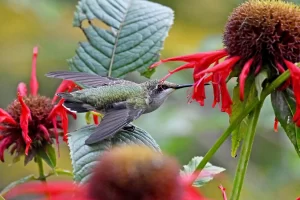Mini Monstera Guide: A Must-Read for Plant Lovers
With its lush green leaves and striking white variegation, the mini monstera (Monstera adansonii) is a popular houseplant that’s easy to care for. But what exactly is a mini monstera, and how do you grow one?
In this guide, we’ll answer all of your questions about the mini monstera, including its care requirements, propagation, and common problems. We’ll also provide tips on how to create a stunning display of mini monsteras in your home.

So whether you’re a seasoned plant parent or you’re just starting out, read on for everything you need to know about the mini monstera!
Mini Monstera Guide: A Must-Read for Plant Lovers
Mini Monstera Guide: A Must-Read for Plant Lovers
Mini Monstera, also known as rhaphidophora tetrasperma, is a fast-growing, easy-to-care-for plant that is perfect for beginners. It is a tropical plant that is native to the rainforests of Southeast Asia. Mini Monstera has heart-shaped leaves that are green with white variegation. It can grow to be up to 6 feet tall, but it is typically kept smaller by pruning.
Here are some tips for caring for your Mini Monstera:
- Light: Mini Monstera needs bright, indirect light. It can tolerate some direct sunlight, but too much sun can scorch the leaves.
- Water: Mini Monstera needs to be watered regularly, but it does not like to sit in wet soil. Allow the soil to dry out slightly between waterings.
- Fertilizer: Mini Monstera does not need to be fertilized often. Fertilize it once a month with a diluted liquid fertilizer during the growing season.
- Pruning: Mini Monstera can be pruned to keep it at a manageable size. Prune it by cutting off the stems at the desired height.
- Repotting: Mini Monstera will need to be repotted every year or two as it grows. Repot it into a pot that is one size larger than the current pot.
Mini Monstera is a beautiful and low-maintenance plant that is perfect for adding a touch of greenery to your home. With proper care, your Mini Monstera will thrive and provide you with years of enjoyment.
Table of Contents
- Introduction to Mini Monstera
- Care Tips for Mini Monstera
- Pruning and Repotting Mini Monstera
- Troubleshooting Common Problems
- Conclusion
What is a Mini Monstera?
What is a Mini Monstera?
Mini Monstera, also known as Rhaphidophora Tetrasperma, is a fast-growing, vining plant that is a popular choice for indoor gardeners. It is a relatively low-maintenance plant that is easy to care for, and it can tolerate a wide range of conditions.
Mini Monstera Care
Mini Monsteras are relatively easy to care for, but there are a few things you can do to keep them healthy and happy.
- Light: Mini Monsteras need bright, indirect light to thrive. They can tolerate some direct sunlight, but too much sun can scorch their leaves.
- Water: Mini Monsteras need to be watered regularly, but they should not be allowed to sit in water. Allow the soil to dry out slightly between waterings.
- Fertilizer: Mini Monsteras do not need to be fertilized often. Fertilize them once a month with a diluted liquid fertilizer during the growing season.
- Temperature: Mini Monsteras prefer warm temperatures between 65 and 85 degrees Fahrenheit. They can tolerate cooler temperatures, but they will not grow as quickly.
- Humidity: Mini Monsteras prefer high humidity. Mist them regularly or place them in a humid environment, such as a bathroom or kitchen.
Mini Monstera Propagation
Mini Monsteras can be propagated by stem cuttings.
Remove the leaves from the bottom half of the cutting, and then dip the cutting in rooting hormone. Place the cutting in a pot of moist potting soil, and keep the soil moist until the cutting has rooted.To propagate a Mini Monstera, simply take a stem cutting that is about 4 inches long and has at least two leaves..
Mini Monstera Problems
Mini Monsteras are generally healthy plants, but they can occasionally be affected by pests or diseases.
- Pests: Mini Monsteras can be affected by pests such as mealybugs, aphids, and spider mites. To control pests, you can use a neem oil spray or insecticidal soap.
- Diseases: Mini Monsteras can be affected by diseases such as root rot and leaf spot. To prevent diseases, you can water your plants properly and make sure they are not exposed to too much moisture.
Mini Monstera FAQs
- Q: How big does a Mini Monstera get?
A: A Mini Monstera can grow to be about 3 feet tall and wide.
- Q: How long does it take for a Mini Monstera to grow?
A: A Mini Monstera can grow to maturity in about 2 years.
- Q: Is a Mini Monstera toxic to cats or dogs?
A: No, a Mini Monstera is not toxic to cats or dogs.
- Q: What is the best soil for a Mini Monstera?
A: A Mini Monstera does best in a well-draining soil that is rich in organic matter.
- Q: How often should I water my Mini Monstera?
A: You should water your Mini Monstera when the top inch of soil is dry.
- Q: What fertilizer should I use for my Mini Monstera?
A: You can use a diluted liquid fertilizer once a month during the growing season.
How to Care for a Mini Monstera
How to Care for a Mini Monstera
Mini Monsteras are a popular houseplant because they’re easy to care for and they’re beautiful. Here are a few tips on how to keep your mini Monstera healthy and happy:
- Light: Mini Monsteras need bright, indirect light. A south-facing window is ideal, but they can also do well in an east-facing window. If your home doesn’t get a lot of natural light, you can use a grow light to supplement.
- Water: Mini Monsteras need to be watered regularly, but they don’t like to sit in wet soil. Allow the top inch of soil to dry out before watering again.
- Fertilizer: Mini Monsteras only need to be fertilized once a month during the growing season. Use a diluted liquid fertilizer or a slow-release fertilizer.
- Humidity: Mini Monsteras like a humid environment. If your home is dry, you can mist the leaves regularly or place the plant on a pebble tray filled with water.
- Pests: Mini Monsteras are susceptible to pests like aphids, mealybugs, and spider mites. If you see any pests, treat them with a neem oil spray or insecticidal soap.
Troubleshooting:
- If your mini Monstera’s leaves are yellowing, it’s probably not getting enough light. Move it to a brighter spot.
- If your mini Monstera’s leaves are wilting, it’s probably overwatered. Allow the soil to dry out before watering again.
- If your mini Monstera’s leaves are browning, it’s probably not getting enough humidity. Mist the leaves regularly or place the plant on a pebble tray filled with water.
- If your mini Monstera is infested with pests, treat it with a neem oil spray or insecticidal soap.
Propagating a Mini Monstera
Propagating a Mini Monstera
Mini Monsteras are a popular houseplant, and for good reason! They’re easy to care for, they’re beautiful, and they’re relatively inexpensive. If you’re looking to propagate your own Mini Monstera, here are a few tips:
- Choose a healthy leaf. The best leaves for propagation are those that are healthy and have no signs of damage or disease. Look for leaves that are green and firm, with no brown or yellow spots.
- Remove the leaf from the plant. To remove the leaf, use a sharp knife or pair of scissors to cut it off at the base of the stem. Be sure to leave a small portion of the stem attached to the leaf.
- Place the leaf in water. Fill a small glass or jar with water and place the leaf in it. The water should be just deep enough to cover the bottom of the leaf.
- Place the leaf in a warm, bright spot. The leaf will need to be in a warm, bright spot in order to root. A south-facing window is ideal.
- Change the water every few days. Make sure to change the water every few days to prevent it from becoming stagnant. You can also add a little bit of rooting hormone to the water to help the roots grow faster.
- Be patient. It can take a few weeks for the leaf to start to root. Once the roots have formed, you can transplant the leaf into a pot of soil.
With a little patience, you can easily propagate your own Mini Monstera. Just follow these tips, and you’ll be enjoying your new plant in no time!
Table of Contents
- What is a Mini Monstera?
- How to Care for a Mini Monstera
- Propagating a Mini Monstera
- Troubleshooting
Troubleshooting Common Mini Monstera Problems
Troubleshooting Common Mini Monstera Problems
Mini Monsteras are relatively easy to care for, but there are a few common problems that can occur. Here’s how to troubleshoot them:
- Yellow leaves can be caused by a variety of factors, including overwatering, underwatering, too much sun, or too little sun. To fix this problem, check the soil moisture and adjust accordingly. Make sure your plant is getting enough light, but not too much.
- Brown leaves can be caused by a number of factors, including pests, diseases, or environmental conditions. If you see brown leaves on your mini Monstera, inspect the plant for pests and diseases. If you don’t see any pests or diseases, try adjusting the environmental conditions. For example, if your plant is getting too much sun, move it to a shadier spot.
- Wilted leaves can be caused by underwatering or too much heat. To fix this problem, water your plant more frequently and make sure it’s not in direct sunlight.
- Root rot is a serious problem that can kill your mini Monstera. It’s caused by overwatering, which leads to the roots rotting. To fix this problem, you’ll need to repot your plant in fresh soil and water it less frequently.
Here are some tips for preventing common mini Monstera problems:
- Water your plant regularly, but don’t overwater it. The best way to check if your plant needs water is to stick your finger in the soil. If the soil is dry to the touch, it’s time to water your plant.
- Give your plant plenty of bright, indirect light. Mini Monsteras need bright light to thrive, but they can’t tolerate direct sunlight.
- Fertilize your plant regularly with a diluted liquid fertilizer. Mini Monsteras don’t need a lot of fertilizer, but they will benefit from a monthly feeding.
- Repot your plant every year or two as it grows. Mini Monsteras will eventually outgrow their pots, so it’s important to repot them as they grow.
By following these tips, you can help your mini Monstera stay healthy and happy.
Where to Buy a Mini Monstera
Where to Buy a Mini Monstera
Online:
- The Sill: The Sill offers a variety of mini monsteras, including the Albo Variegata, Peru, and Adansonii. They also offer a variety of shipping options, so you can get your new plant as quickly as possible.
- Plants.com: Plants.com has a wide selection of mini monsteras, including the Albo Variegata, Peru, and Adansonii. They also offer a variety of discounts and promotions, so you can save money on your new plant.
- Etsy: Etsy is a great place to find unique and rare mini monsteras. You can find sellers from all over the world, so you’re sure to find a plant that’s perfect for you.
Local nurseries:
- Check your local nurseries to see if they carry mini monsteras. You can also ask the staff for recommendations on which plants are best suited for your climate and growing conditions.
- If you can’t find a mini monstera at your local nursery, you can also try contacting them to see if they can order one for you.
Tips for buying a mini monstera:
- When choosing a mini monstera, look for a plant that is healthy and has no signs of pests or diseases.
- The leaves should be green and glossy, and the stems should be sturdy.
- Avoid plants that are wilted, have yellow leaves, or are infested with pests.
- When you’re bringing your new plant home, make sure to acclimate it to its new environment gradually. Start by placing it in a shady spot and gradually increase the amount of sunlight it receives over time.
- Water your mini monstera regularly, but make sure not to overwater it. Allow the soil to dry out slightly between waterings.
- Mist your mini monstera regularly to help keep the leaves clean and free of dust.
- Fertilize your mini monstera once a month with a diluted fertilizer.
By following these tips, you can help ensure that your mini monstera thrives and grows into a beautiful plant.
Resources
This article from The Spruce provides detailed information on how to care for a mini monstera, including watering, light, and soil requirements. It also includes tips on how to propagate and repot your plant.
This article from Gardening Know How discusses the different varieties of mini monstera, including their size, shape, and leaf color. It also provides information on where to buy mini monsteras and how to care for them.
To Wrap It Up
Mini Monsteras are a great way to add a touch of greenery to your home without taking up too much space. They’re also relatively easy to care for, making them a good choice for beginner plant parents.
If you’re looking for a unique and low-maintenance plant to add to your collection, a mini Monstera is a great option. Just be sure to give it plenty of bright indirect light and water it regularly, and you’ll be rewarded with a beautiful and thriving plant.
If you’re ready to add a mini Monstera to your home, be sure to check out our guide on how to care for them. You can also find mini Monsteras for sale at most garden centers and online retailers.
- Cat Palm vs Majesty Palm: Which Should You Choose? - June 30, 2024
- Flowers That Survive Winter: Discover the Exceptional No. 5 - June 30, 2024
- The Ultimate Guide to the Growth and Care of the Black Pagoda Lipstick Plant - June 29, 2024





